Deal or no deal?
Page 34
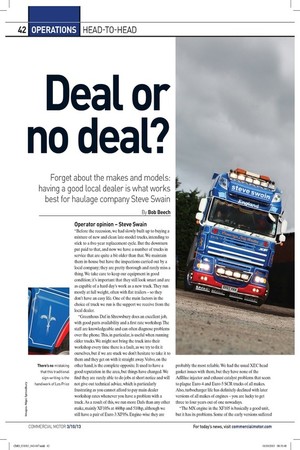
Page 35
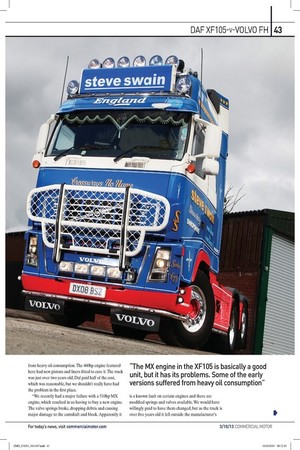
Page 36
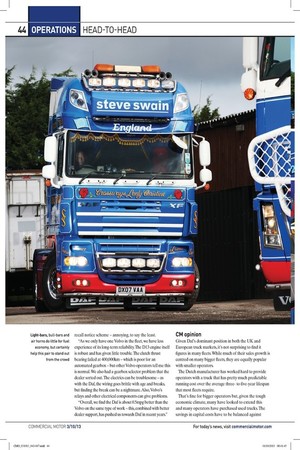
Page 37
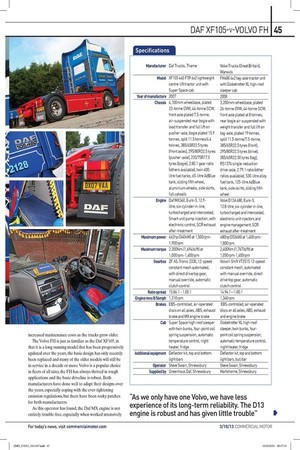
Page 38
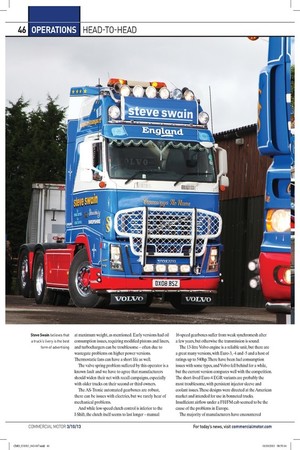
Page 39
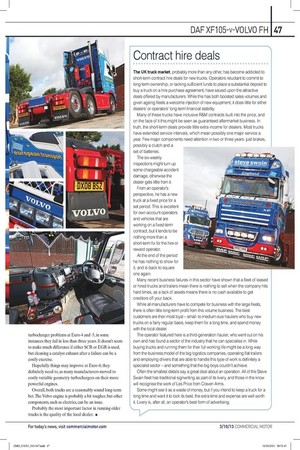
If you've noticed an error in this article please click here to report it so we can fix it.
Forget about the makes and models: having a good local dealer is what works best for haulage company Steve Swain By Bob Beech Operator opinion Steve Swain
"Before the recession, we had slowly built up to buying a mixture of new and clean late-model trucks, intending to stick to a five-year replacement cycle. But the downturn put paid to that, and now we have a number of trucks in service that are quite a bit older than that. We maintain them in-house but have the inspections carried out by a local company; they are pretty thorough and rarely miss a thing. We take care to keep our equipment in good condition; it's important that they still look smart and are as capable of a hard day's work as a new truck. They run mostly at full weight, often with flat trailers — so they don't have an easy life. One of the main factors in the choice of truck we run is the support we receive from the local dealer. "Greenhous Daf in Shrewsbury does an excellent job, with good parts availability and a first rate workshop. The staff are knowledgeable and can often diagnose problems over the phone. This, in particular, is useful when running older trucks. We might not bring the truck into their workshop every time there is a fault, as we try to fix it ourselves, but if we are stuck we don't hesitate to take it to them and they get on with it straight away. Volvo, on the other hand, is the complete opposite. It used to have a good reputation in the area, but things have changed. We find they are rarely able to do jobs at short notice and will not give out technical advice, which is particularly frustrating as you cannot afford to pay main dealer workshop rates whenever you have a problem with a truck. As a result of this, we run more Dafs than any other make, mainly XF105s at 460hp and 510hp, although we still have a pair of Euro-3 XF95s. Engine-wise they are
probably the most reliable. We had the usual XEC head gasket issues with them, but they have none of the AdBlue injector and exhaust catalyst problems that seem to plague Euro-4 and Euro-5 SCR trucks of all makes. Also, turbocharger life has definitely declined with later versions of all makes of engines — you are lucky to get three to four years out of one nowadays. "The MX engine in the XF105 is basically a good unit, but it has its problems. Some of the early versions suffered
from heavy oil consumption. The 460hp engine featured here had new pistons and liners fitted to cure it. The truck was just over two years old; Daf paid half of the cost, which was reasonable, but we shouldn't really have had the problem in the first place. "We recently had a major failure with a 510hp MX engine, which resulted in us having to buy a new engine. The valve springs broke, dropping debris and causing major damage to the camshaft and block. Apparently it is a known fault on certain engines and there are modified springs and valves available. We would have willingly paid to have them changed, but as the truck is over five years old it fell outside the manufacturer's
recall notice scheme — annoying, to say the least.
"As we only have one Volvo in the fleet, we have less experience of its long-term reliability. The D13 engine itself is robust and has given little trouble. The clutch thrust bearing failed at 400,000km — which is poor for an automated gearbox — but other Volvo operators tell me this is normal. We also had a gearbox selector problem that the dealer sorted out. The electrics can be troublesome — as with the Daf, the wiring goes brittle with age and breaks, but finding the break can be a nightmare. Also, Volvo's relays and other electrical components can give problems.
"Overall, we find the Daf is about 0.5mpg better than the Volvo on the same type of work — this, combined with better dealer support, has pushed us towards Daf in recent years." CM Opinion
Given Daf's dominant position in both the UK and European truck markets, it's not surprising to find it figures in many fleets. While much of their sales growth is centred on many bigger fleets, they are equally popular with smaller operators.
The Dutch manufacturer has worked hard to provide operators with a truck that has pretty much predictable running cost over the average threeto five-year lifespan that most fleets require. That's fine for bigger operators but, given the tough economic climate, many have looked to extend this and many operators have purchased used trucks. The savings in capital costs have to be balanced against
increased maintenance costs as the trucks grow older.
The Volvo FH is just as familiar as the Daf XF105, in that it is a long running model that has been progressively updated over the years, the basic design has only recently been replaced and many of the older models will still be in service in a decade or more. Volvo is a popular choice in fleets of all sizes, the FH has always thrived in tough applications and the basic driveline is robust. Both manufacturers have done well to adapt their designs over the years, especially coping with the ever-tightening emission regulations, but there have been rocky patches for both manufacturers. As this operator has found, the Daf MX engine is not entirely trouble-free, especially when worked intensively
at maximum weight, as mentioned. Early versions had oil consumption issues, requiring modified pistons and liners, and turbochargers can be troublesome — often due to wastegate problems on higher power versions. Thermostatic fans can have a short life as well.
The valve spring problem suffered by this operator is a known fault and we have to agree that manufacturers should widen their net with recall campaigns, especially with older trucks on their second or third owners.
The AS-Tronic automated gearboxes are robust, there can be issues with electrics, but we rarely hear of mechanical problems. And while low-speed clutch control is inferior to the I-Shift, the clutch itself seems to last longer — manual
16-speed gearboxes suffer from weak synchromesh after a few years, but otherwise the transmission is sound.
The 13-litre Volvo engine is a reliable unit, but there are a great many versions, with Euro-3, -4 and -5 and a host of ratings up to 540hp. There have been fuel consumption issues with some types, and Volvo fell behind for a while, but the current version compares well with the competition. The short-lived Euro-4 EGR variants are probably the most troublesome, with persistent injector sleeve and coolant issues. These designs were directed at the American market and intended for use in bonneted trucks. Insufficient airflow under a FH/FM cab seemed to be the cause of the problems in Europe. The majority of manufacturers have encountered
turbocharger problems at Euro-4 and -5, in some instances they fail in less than three years. It doesn't seem to make much difference if either SCR or EGR is used, but cleaning a catalyst exhaust after a failure can be a costly exercise.
Hopefully things may improve at Euro-6; they definitely need to, as many manufacturers moved to costly variable geometry turbochargers on their more powerful engines.
Overall, both trucks are a reasonably sound long-term bet. The Volvo engine is probably a bit tougher, but other components, such as electrics, can be an issue. Probably the most important factor in running older trucks is the quality of the local dealer. •











































